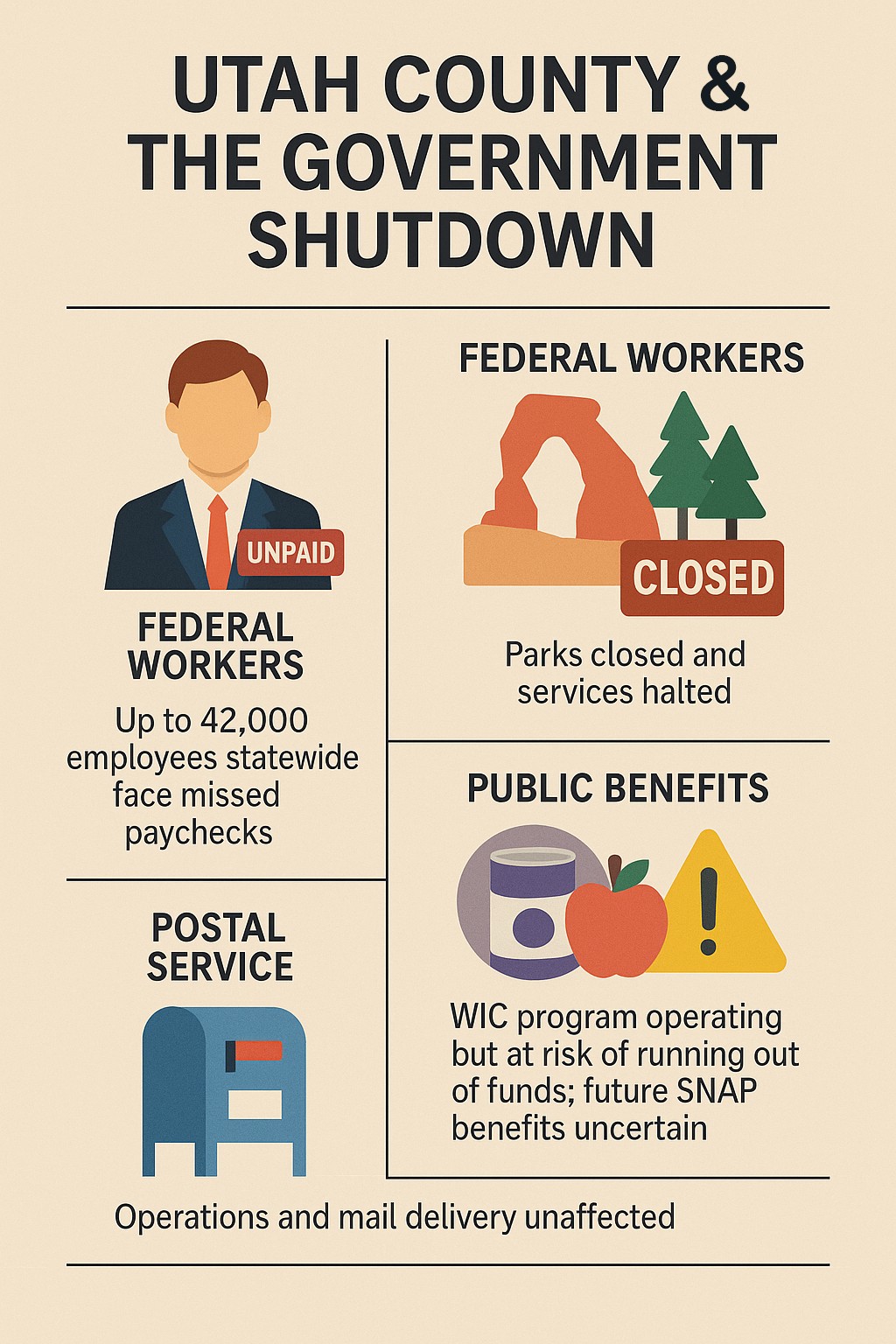Local News
The impact of the Federal Government shutdown for Utah County residents
Published
2 months agoon

April Slaughter & Megan Wallgren | Lehi Free Press
As the federal government enters its second week of shutdown, Utah County residents are beginning to experience slower services, closed offices, and uncertainty regarding benefits and federal support.
The shutdown began Oct. 1 after Congress failed to pass funding for the new fiscal year. Many non-essential federal workers have been furloughed, while others classified as essential continue to work without pay.
In Utah, an estimated 42,000 workers could miss paychecks during the shutdown, accounting for approximately 2.4% of the state’s workforce, according to state labor officials. The longer the stalemate drags on, the more strain it’s expected to place on local families and small businesses.
Lehi Mayor Mark Johnson said the city is not experiencing any immediate disruptions to its ability to serve residents. “I do not expect any impacts in the short term,” Johnson said. “We have been through this before and hope that a resolution will soon be achieved.”
“It is possible that some federal grant money could be delayed, but we are receiving very little in federal dollars right now,” Johnson said.
Utah County programs rely more on federal funding and face greater risk due to a prolonged gridlock at the federal level. Utah County Commissioner Skyler Beltran said that while things remain stable for now, several departments could face budget pressures if the shutdown continues.
“Thankfully, we’ve been okay so far. Although the longer it goes, the more it will be felt,” Beltran said. “We have the potential for budget issues in several departments, such as Health, WIC, Mental Health Services, Children’s Justice, and the Forest Service. These are important services for many in our community, and we continue to ensure they can be delivered to the best of our ability.”
Beltran added that county officials are keeping in contact with Utah’s congressional delegation to address potential problems. “I also just met with Congressman Kennedy on Wednesday to discuss the current status of the shutdown and to work through any issues we see on the horizon,” he said. “He’s optimistic that the end is near and that, hopefully, services won’t be interrupted much longer.”
Outdoor enthusiasts are already seeing the effects. The state has committed to keeping Utah’s “Mighty 5” national parks open during the shutdown, but with reduced staffing and fewer services. Visitor centers, trash collection, restrooms, and guided programs may be scaled back to only those essential for health, safety, and emergency functions. The Utah Division of State Parks states that its parks are unaffected by the shutdown, as they’re funded at the state level.
Still, smaller federal recreation sites around Utah County have shut entirely. That means cave tours, visitor centers and maintained trails at places like Timpanogos Cave National Monument are closed until funding is restored.
At the Internal Revenue Service, operations have been severely curtailed. Nearly half of its workforce is being furloughed, leaving only about 53.6% of employees active during the shutdown. That reduction is expected to lead to lengthy delays in processing paper tax returns, mailed payments or audits. In northern Utah, some IRS employees have said that the abrupt rules surrounding leave, furloughs and return-to-work schedules are generating anxiety.
Meanwhile, federal offices with a local presence are operating with reduced capacities. The Provo Social Security field office is currently open for essential functions. However, nonurgent services, such as issuing verification letters or adjusting earnings records, are being postponed until full funding is restored. Social Security benefit payments are expected to continue on schedule because those funds are held in a trust, rather than relying on annual budget approvals.
The U.S. District Court in Utah reports that it can maintain operations through at least Oct. 17 by tapping judicial fee reserves. Most federal court dates, filings and deadlines remain in effect for now. However, officials warn that if the shutdown drags on, some proceedings may be delayed, especially those considered less critical.
Mail service won’t be affected by the shutdown. The U.S. Postal Service will continue to operate as usual because it is independent and relies on postage sales and other revenue sources, rather than annual federal funding.
Some federal agencies responsible for public safety are exempt and continue to operate. TSA, air traffic control, and federal law enforcement continue their work at airports and in federal jurisdictions, although their staff are now working without pay. At Utah airports, there have been no significant disruptions yet, and security checkpoints and air traffic control remain functional. However, there are early signs nationwide of strain: more controllers are calling out sick, and some airports have experienced delays and even temporary closures due to staffing shortfalls. The FAA says it is reducing the flow of air traffic in some regions to ensure safety, and Utah officials are monitoring airports in Salt Lake City and Provo for any potential ripple effects.
Several public benefit programs face uncertainty. In Utah County, the Women, Infants, and Children (WIC) nutrition program continues to operate under contingency funding, although program officials caution that its status depends on securing ongoing funds. SNAP, the Supplemental Nutrition Assistance Program, received funding for October benefits, but future disbursements may not be guaranteed if the shutdown continues. The Home Energy Assistance Target (HEAT) program has suspended accepting new applications, complicating matters for low-income households in colder months.
Anxiety among federal employees in Utah is growing. At an IRS facility in Ogden, some workers have reported receiving notices of reduced pay or furlough status. Many worry that this time, they might not receive automatic back pay—a departure from past shutdowns.
Utah’s lawmakers say the state is already bleeding financial losses. Rep. Blake Moore estimates that, in just one week, the shutdown has cost Utah approximately $157 million.
For Utah County residents, the key takeaway is to expect delays, call ahead, and plan for potential disruptions. If you have federal business—especially with tax, recreation or benefits offices—confirm whether the office is open or operating in a limited capacity before visiting. For households relying on assistance, applying now for alternative local or state aid may cushion the gap. And if you are a federal employee, know that resources such as 2‑1‑1 or nonprofit aid networks may help during this uncertain pause in pay.
Until Congress passes spending legislation, many federal services in Utah County will remain on hold—even as essential functions attempt to maintain stability.

You may like
-


Pioneer girls drop three to tough teams in hoops
-


Give a piece of Lehi from the Lehi Historical Society gift shop
-


Students, Jazz Bear team up for annual holiday shopping event
-


The Ruth’s “Charlie and the Chocolate Factory” a whimsical treat
-


Lehi Free Press
-


UCHD confirms new measles case in Utah County
-


Barriers near 2100 West cause confusion for Lehi residents
-


Lehi to host national hoops showcase
-


Pioneer boys begin with tough schedule
-


Falcon boys make promising start

